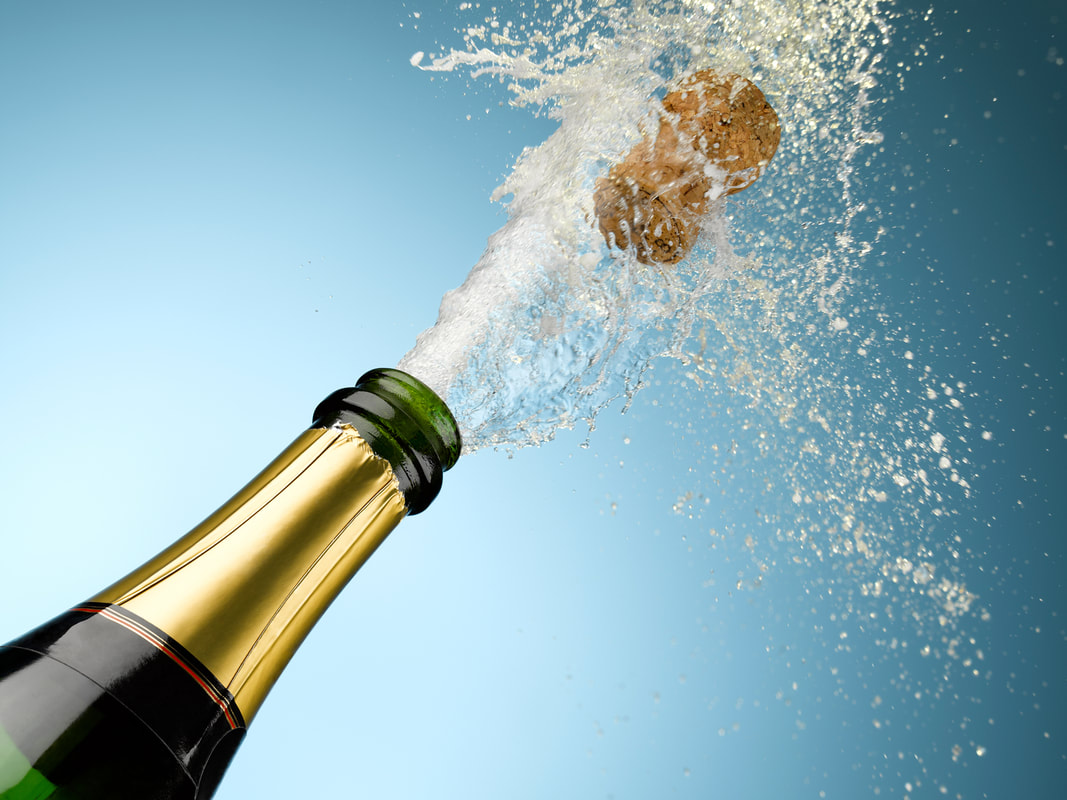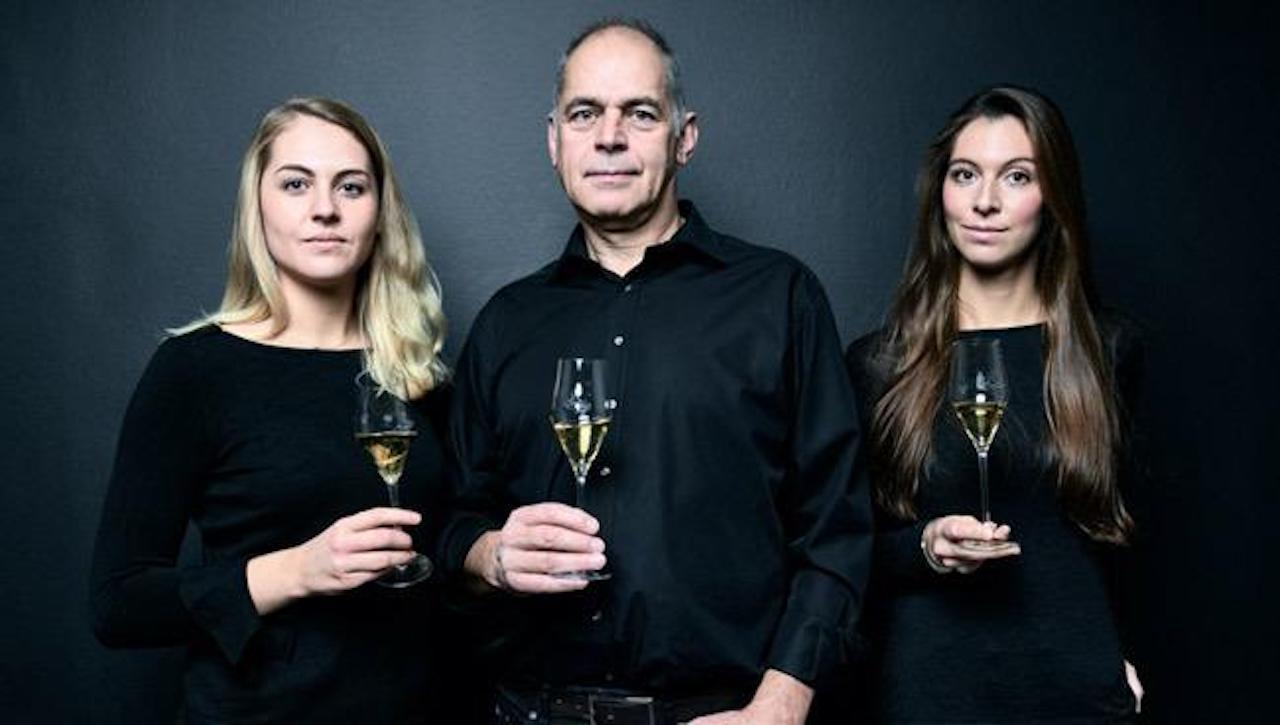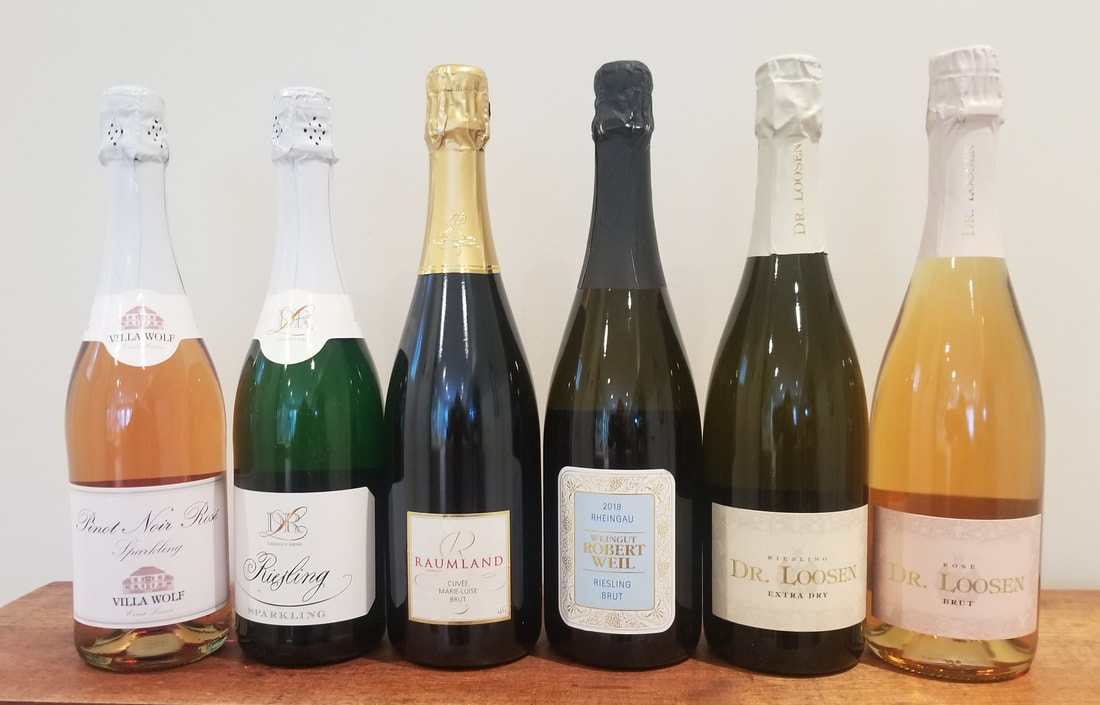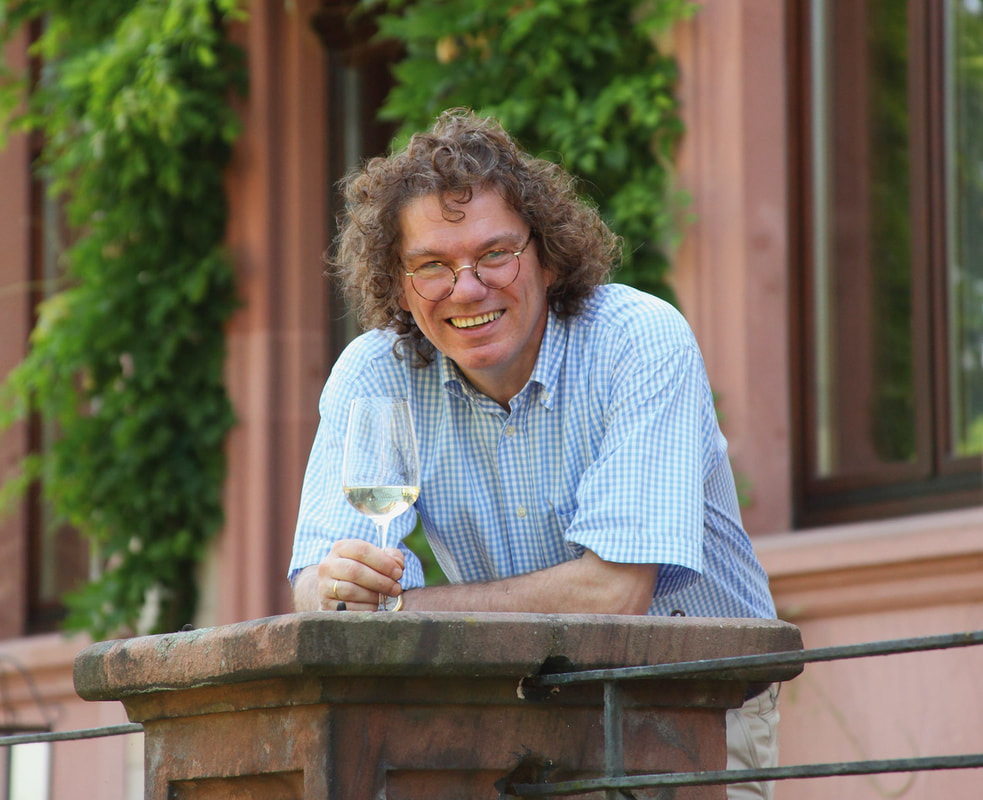|
The holidays are fast approaching, and nothing sets the mood like the sound of a cork being removed from sparkling wine. It is the quintessential “pop” that signals “let the festivities begin.” With so many styles of sparkling wine available from around the world, it can be daunting as to what wine to choose. Each country and its respective region has its name for sparkling wine, and the selection is vast. The list includes noted wines such as Champagne from the Champagne region, Crémant, made outside of the Champagne region of France, Cava from Spain, and Prosecco and Franciacorta from Italy. And then there is Sekt (pronounced Zekt), a sparkling wine produced in Germany. If you are not familiar with Sekt, then let me introduce you to these palatable wines! A Brief History Sekt, also called “Schaumwein “(sparkling wine” in German), has been called such since the late 1800s. Documents date back to the 18th century, alluding to “wine re-fermenting in the bottle,” but it wasn’t until 1826 that Sekt was first recorded. At the beginning of the 19th century, many German winemakers and winery owners traveled to Champagne to learn the technique of making quality sparkling wine. Among them was Georg Christian Kessler, who worked as an employee at Veuve Clicquot and then brought his expertise back to Germany. He established Sektkellerei Kessler in 1826, located near Stuttgart, the oldest sparkling wine producer in Germany. They only make Sekt using the traditional method (Klassische Flaschengärung in German,) where the second fermentation takes place in the bottle. Many of the German winemakers who traveled to Champagne back then remained in France and established Champagne houses that are thriving today like Krug, Mumm, Taittinger, Roederer, and Bollinger. World War 1 and II brought devastation to the vineyards, economy, and the downfall of sparkling wine in Germany. It wasn’t until the 1960s when a new method of making sparkling wine, other than the traditional method, was introduced, called the Charmat (tank) method (second fermentation takes place in the tank). This led to faster and more economical production, but unfortunately, the quality went down as production quantity revved up. However, the traditional method was not lost entirely. In the 1970s, young winemakers once again sought guidance from Champagne and became educated on the importance of terroir, which plays a vital role in the outcome of the wine, and production techniques. By the late 1980s, several winemakers set out on a mission to bring Sekt back to its original status. One of these innovators is Volker Raumland who founded Sekthaus Raumland in 1990. He has been described as the pioneer who “dared to start a new quality revolution in German Sparkling Wine. His two daughters Marie-Luise and Katharina joined the family estate in 2020, continuing with the same passion and love for high-quality German sparkling wine that their parents had and still have.” Sekthaus Raumland is dedicated strictly to pioneering modern, high-quality German Sekt. The estate doesn’t produce a single still wine! Raumland’s renowned high-quality sparkling wines made Volker a popular partner for other German wineries looking to make their own sparkling wines. In fact, Raumland makes Sekt for approximately 40 to 50 other German wineries. Today, Germany is making significant strides with sparkling wines. Here are some statistics. ➣Germany is the third-largest sparkling wine producer, with Italy number one and France following second. ➣Germany produced 9.0 million hectoliters of wine in 2019 (even though this is from the 2020/2021 report, the most recent figures are all from 2019). ➣Germany is the largest consumer of sparkling wine, with France, the US, Russia, and Italy following respectively. ➣3.4 million hectoliters of Sekt were consumed by Germans in 2019. ➣Germany is the 4th largest consumer of total wine; 20.4 million hectoliters in 2019. The USA tops the list with France and Italy following respectively. Stats provided by Wines Of Germany Most of the low-quality Sekt is consumed in Germany and not exported. It can be made with German grapes or bulk wine from other European countries. Fine German Sekt, Traditionelle Flaschengärung, is exported in very limited quantities, but smaller estates are now striving to make fine Sekt. When looking at a Sekt wine label, keep this chart in mind. Deutscher Sekt It must be made from German base wine. It can be made in the tank (minimum 90 days on yeast, 30 of those with continuous mixing). It can be made with traditional bottle fermentation (minimum nine months on lees). Deutscher Sekt b.A. It is the same as above but with a minimum of 85% of the grapes sourced from one of Germany’s 13 wine regions. Winzersekt It must be made by traditional bottle fermentation, with a minimum of nine months on lees. However, most winemakers far exceed that length. It must be 100% estate-grown fruit. The label must state grape variety and vintage. For more information about wine classification, sweetness levels, new regulations and quality standards for German wine, and an interview with Ernst Loosen, please refer to my article German Rieslings, First Stop Mosel. Riesling is Germany’s most celebrated grape variety, with the world’s largest vineyard area of 23,000 hectares dedicated to this grape. So, it stands to reason that Riesling plays a dominant role in the production of Sekt. However, Chardonnay, Spätburgunder (Pinot Noir), Weissburgunder (Pinot Blanc), and Grauburgunder (Pinot Gris) are also used, in addition to other varieties. Germany has ideal conditions for growing grapes to make sparkling wine. The climate, terroir, and especially the mineral-rich, slate soil yields light-bodied, high-acid wines. Styles range from extra dry to sweet. And sparkling wines made by Traditionelle Flaschengärung have so much depth and character. So, let’s explore some Sekt! Dr. Loosen The Dr. Loosen estate has been in the same family for over 200 years. When Ernst Loosen assumed ownership in 1988, he realized that he had vines in some of Germany’s best-rated vineyards. To maximize the potential of those vines, he dramatically crop-sized, uses only organic fertilization, insists on very strict fruit selection, and employs gentle cellar practices with a minimum of handling. Dr. L Sparkling Riesling NV (Deutscher Riesling Sekt) This wine is made with 100% Riesling using the Charmat method. It is very aromatic with floral and citrus notes that continue onto the palate with white stone fruit, apple, and pink grapefruit. Creamy bubbles and lively acidity complete this fruit-forward wine. Alcohol: 12% SRP: $16 Dr. Loosen Riesling Sekt Extra Dry NV This sparkling wine is made with 100% Riesling sourced from estate vineyards in the Mosel region and produced using Traditionelle Flaschengärung, with 15 months on the lees in bottle. It has all the classic aromas and flavors that one would expect from a Riesling with green apple, peach, nectarine, and racy acidity. Persistent, fine bubbles envelop the mouth, and hints of white stone fruit linger on the finish. Alcohol: 12% SRP: $25 Erni Loosen said, “Our Dr. L Sparkling and the Dr. Loosen estate Riesling Sekt are meant to be enjoyed as young wines. Personally, though, I much prefer sparkling wines with age, when the bubbles have calmed down, and they’ve had time to develop tertiary aromatics. So that’s what we do with the Pinot Noir Rosé Sekt. It’s done with the classic champagne method, with extended maturation in bottle. We started with five years on the lees before disgorgement and are working up to ten years. That’s when the wine really becomes interesting to me. It’s more complex and more harmonious. That’s what I look for in sparkling wine.” Dr. Loosen Pinot Noir Rosé Sekt Brut 2011 When Erni purchased a small parcel of vines in the Ürziger Würzgarten vineyards, a grand cru site in the Mosel region, he thought it was entirely Riesling. It wasn’t until the onset of the grapes ripening in the summer that Erni discovered this parcel was Pinot Noir! The question became what to do with these grapes since there isn’t a strong tradition of Pinot Noir on the Mosel. Erni combined his love for Pinot Noir and passion for great sparkling wine to produce this Rosé Sekt. 2011 is the first vintage release of their 100% Pinot Noir Rosé Sekt. It is produced using Traditionelle Flaschengärung with five years of bottle aging on the lees before disgorgement. Beautiful aromatic notes of floral and berries spill onto the palate with cherry, raspberry, vibrant acidity, and minerality. Creamy and persistent bubbles add to the lushness of this wine. Alcohol: 12.5% SRP: $35 Villa Wolf Pinot Noir Sparkling Rosé NV (Deutscher Sekt) Erni Loosen owns Villa Wolf, located in the Pfalz region in the Rhine river valley in southwest Germany, directly north of France’s Alsace region. The Villa Wolf varietal line-up includes exceptionally affordable, classic Pfalz wines made from traditional grape varieties. Because the Villa Wolf Pinot Noir Rosé still wine is so popular, Erni decided to make a sparkling version. Like Dr. L, the Villa Wolf Sparkling Pinot Noir Rosé is made using the Charmat method. Lovely aromas of floral, berries and watermelon, give way to a light and refreshing palate with a nice balance of acidity and minerality and a gentle spritz. Alcohol: 12.5% SRP: $16 Robert Weil Rheingau Riesling Sekt Brut 2018 The 2018 Robert Weil Riesling Sekt Brut is produced by the top Sekt producer in Germany, Raumland Sektkelleri. Raumland’s renowned high-quality sparkling wines made Volker a popular partner for other German wineries looking to make their own sparkling wines. Partnering with Raumland was an easy decision for Robert Weil because both strive for the highest quality in their wines. The Robert Weil estate was founded in 1875 and is considered one of the finest producers in the Rheingau region. Wilhelm Weil, 4th-generation, now presides over the estate. This 100% Riesling was harvested from parcels neighboring the great Kiedrich Gräfenberg Grosse Lage vineyard. It is produced using the Traditionelle Flaschengärung method and matured on the lees in bottle for 20 months before disgorgement.
Delicious fruit aromas, citrus, and floral lead to a beautiful palate of honeysuckle, pear, green apple, lemon, and minerality. Persistent bubbles, crisp acidity, and a trace of sweetness add to the allure of this wine. Alcohol: 12% SRP: $47 Nicolas Pfaff, Robert Weil Export Manager, added: “The basic wines of our Riesling Sekt Brut originates from vineyards with high elevation, neighboring our very finest ones. Thanks to the perfect conditions for Riesling, with a cool climate, high amount of slate in the soils, and a typical hillside vineyard, Riesling is created. Afterward, these characteristics are refined with a classic “Méthode Champenoise.” The dosage is always a sweet wine from the famous Gräfenberg vineyard. It adds even more profile to an elegant, classy, and racy Riesling that perfectly reflects the grape variety and its origin.” Sekthaus Raumland Cuvée Marie-Luise Brut 2013 The grapes for this 100% Pinot Noir are hand-harvested from Dalsheimer Bürgel and Hohen Sülzer Kirchenstück vineyards located in the “Rheinhessen” region. The wine is produced using the Traditionelle Flaschengärung method and matured on the lees in bottle for 57 months. Raumland states, “The factor “time” plays a role of paramount importance for our sparklings. Since we only produce vintage sparklings, our “youngest” Sekt lies on lees for a minimum of four years. Our most prestigious Sekt even up to 12 years (without losing its freshness and crisp character).” Seductive aromas of brioche, berries, and cherry lead to an amazing palate with creamy bubbles and vibrant acidity. Soft berries, red apples, toasty notes, and minerality from the chalk soil come through. The elegance of this wine lingers with a long and satisfying finish. Alcohol: 12% SRP: $46 All of the above wines can be enjoyed as an aperitif or try pairing with dishes such as seafood, shellfish, appetizers, cheese, grilled fowl, spicy Asian cuisine, or light dinner fare. I asked Stephen Schmitz, senior director of Wines Of Germany, what his thoughts were about the future of Sekt. Stephen: “In the U.S., German Sekt producers have a huge opportunity to compete in the $18-$40 price tier, where I suspect more of the sparkling wine growth will occur in the next decade. Prosecco dominates the sub-$20 category and Champagne the $40+, but no one region or country has a stranglehold on the in-between. Dollar-for-dollar, I think German Sekts in that $18-$40 range are often better and much more interesting than those from most other countries, certainly at that price point. We can’t talk about the future of Sekt without talking about climate change. The reality is that the Earth is warming rapidly, and wine grapes picked for sparkling wines must be harvested at lower ripeness levels than their still wine counterparts; the category is even more sensitive to warming temperatures. In Germany, where historically achieving optimal ripeness has been the major struggle, the worst effects of climate change on viticulture isn’t so much rising temperatures as it is drought, flooding, or just generally unpredictable weather.” Marie-Luise Raumland added a few comments as well on the future of Sekt. Marie-Luise: “Among the smaller but traditional producers in Germany, I believe that German Sekt will have a major impact on that segment of the market. Just recently, the German Wine Institute declared 2019 as the Year of the German Sparkling wine. However, we still have a long way to go. Thirty-five years ago, we started as a small and unimportant producer of sparkling wine, and others were laughing about our vision to create a high-quality sparkling wine that could compete with other sparkling wines (like Champagne). Nowadays, winemakers from all over the world (recently from England, Greece, and even China) called us to ask for advice. That makes us proud and shows that the reputation of German sparkling wine might get back to where it once was. We totally understand that it takes time to gain back reputation.” Stephen also talked about how the Sekt market is changing and who the consumers are. Stephen: “In short, German Sekt is Sekty again! Here in the U.S., German Sekt imports are up 34% by volume and 25% by value in the first half of 2021, according to Gomberg, Fredrikson & Associates. In today’s world, sparkling wine drinkers skew younger than your average wine consumer, which tracks for Sekt too. Over the last 15 years, Americans have democratized our approach to sparkling wine so that it’s not just expensive bottles for special occasions or cheap swill for New Year’s Eve but rather something to be drunk whenever and at a variety of different price points. Interestingly, this has long been the case in Germany, where they drink more sparkling wine per capita than any other country.” Sekt, which was once considered a bland sparkling wine with no imagination, is now in the middle of a bubbly resurgence. So join the celebration, treat your palate and “pop” open a Sekt! Until next time… Cheers! Penina This article was originally published to Santé Magazine. To leave a comment or if you have an inquiry, please contact me at [email protected] Comments are closed.
|
Categories
All
|






 RSS Feed
RSS Feed